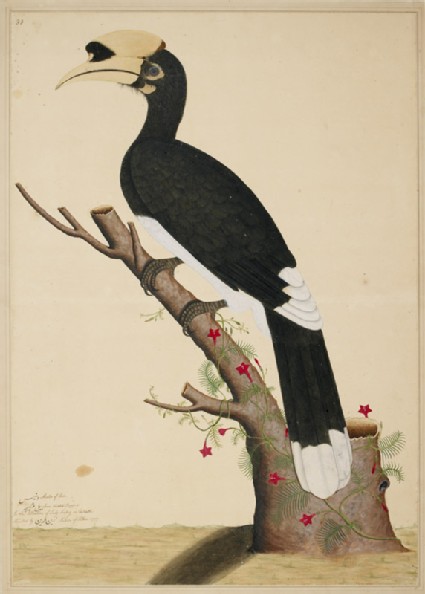Browse: 10610 objects
Pied Hornbill (Anthracoceros malabaricus)
- loan
-
Description
This large, mainly fruit-eating Hornbill is found in forests in India and Nepal. In this early commission for Lady Impey, Shaikh Zain ud-Din depicts the bird perched on a tree stump entwined by a flowering creeper, in the manner of European natural history illustrations that he may have seen in the Impeys’ library, such as the Histoire naturelle (1749-1788) of the Comte de Buffon. Unusually he also includes a shadow effect in the foreground as a gesture to occidental naturalism. An inscription describes Zain ud-Din as ‘Native of Patna’, a major centre in Bihar where he may have previously worked.
-
Details
- Associated place
-
Asia › India › east India › West Bengal › Kolkata (place of creation)Europe › United Kingdom › England (place of creation)
- Date
- 1777
- Artist/maker
-
Shaikh Zain ud-Din (active c. 1770 - 1785) (artist)Whatman (established 1740) (manufacturer)
- Associated people
-
Mary, Lady Impey (1749 - 1818) (commissioner)Sir Henry Wentworth Acland, first Baronet (1815 - 1900) (owner)
- Material and technique
- gouache on paper
- Dimensions
-
mount 112 x 81.5 cm (height x width)
page 85.5 x 59.8 cm (height x width)
- Material index
- Technique index
- Object type index
- No. of items
- 1
- Credit line
- Lent by the Radcliffe Science Library, University of Oxford.
- Accession no.
- LI901.7
Past Exhibition
see (1)Location
-
- currently in research collection
Objects are sometimes moved to a different location. Our object location data is usually updated on a monthly basis. Contact the Jameel Study Centre if you are planning to visit the museum to see a particular object on display, or would like to arrange an appointment to see an object in our reserve collections.
© 2013 University of Oxford - Ashmolean Museum


